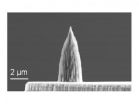Queen's research gives fresh hope to couples with 'unexplained infertility'
2012-11-14
(Press-News.org) New research from Queen's University Belfast has uncovered the cause of infertility for 80 per cent of couples previously diagnosed with 'unexplained infertility'.
At present some 50,000 couples require fertility treatment across the UK each year, with the figure reaching one million worldwide. Up to one third of these couples are diagnosed with unexplained or idiopathic infertility. This means that, using current tests, neither partner has been diagnosed with any detectable problem.
Published in Reproductive Biomedicine Online, and carried out by Professor Sheena Lewis from the School of Medicine, Dentistry and Biomedical Sciences at Queen's, the new research reveals 80 per cent of couples with unexplained or idiopathic infertility in the large study of 239 couples have a detectable cause known as high sperm DNA damage.
The new study is the first of its kind and will lead to better treatment for these couples, saving them time, money and heartache.
Explaining the research, Professor Lewis said: "The majority of couples experiencing problems with fertility are able to receive an explanation for their infertility. These causes range from low sperm count, poor sperm motility in the man to blocked fallopian tubes or endometriosis in the woman. Once the causes for infertility have been established the appropriate course of assisted conception treatment can be undertaken.
"For almost one third of couples, until now, there has been no obvious cause for infertility and these couples are given the diagnosis of 'unexplained fertility'. These couples often invest a lot of time and money in fertility treatments like intrauterine insemination (IUI) unlikely to be successful. In our study we have now had a breakthrough which explains the cause of infertility for many of those couples. Now that we have found the cause of infertility for these couples suitable treatments can be tailored for them which will direct them straight to the best treatment and increase their chances of having a baby."
The study also has a second major finding. It is the first study to show that the chances of having a baby after IVF is closely related to the amount of DNA damage a man has in each of his sperm. A little damage is normal (under 15 per cent per sperm), as is seen in the sperm of fertile men. But if the damage reaches clinically important levels (high sperm DNA damage more than 25 per cent per sperm) it will reduce the couples' chances of a family, even with some forms of fertility treatment. These findings are the latest in a series of studies performed by the internationally recognised male fertility research team based at Queen's Centre for Public Health involving over 500 couples.
The research was carried out using a unique test for male fertility called the SpermComet™. Professor Lewis said: "We at Queen's have developed the SpermComet™, which is a unique test for male infertility that measures damaged DNA in individual sperm – providing all couples with specific information about the causes and extent of their infertility. This test can predict the success of infertility treatments and fast-track couples to the treatment most likely to succeed, leading to reduced waiting times and improved chances of success.
"With one million couples worldwide requiring fertility treatment, these new research findings will give many fresh hope of having a family."
Professor Lewis, in partnership with Queen's venture spinout arm, QUBIS, has now set up a company called Lewis Fertility Testing Ltd which is already marketing the test. For more information visit www.lewisfertilitytesting.com
###
For media inquiries please contact Claire O'Callaghan on 028 90975391 or email c.ocallaghan@qub.ac.uk
Notes to Editors:
Professor Sheena Lewis is available for interview. Interview bids to Claire O'Callaghan on 028 9097 5391 or email c.ocallaghan@qub.ac.uk
These findings are the latest in a series of studies performed by the male internationally recognised fertility research team based in Queen's Centre for Public Health and are based on a large study of 239 couples.
The research is published in Reproductive Biomedicine Online and can be found at: http://www.sciencedirect.com/science/article/pii/S1472648312005901
More information on the Spermcomet test can be found at www.lewisfertilitytesting.com
Numbers of couples requiring treatment each year are
UK: 50,000
ROI: 4,500
Europe: 552,250
Worldwide: 1 million
25-30% of these are diagnosed with unexplained or idiopathic infertility
About the SpermComet: The SpermComet provides unique information that no other test offers. By measuring damaged DNA in individual sperm, it can predict the success of infertility treatments and fast-track couples to the treatment most likely to succeed, leading to significantly reduced waiting times and improved chances of conception.
How Sperm DNA testing can guide to the right diagnosis and treatment choice.
a) If sperm have less than 25% damage: The problem is not the sperm DNA.
b) If sperm have more than 25% or more are damaged there is a high risk of infertility and very little chance of natural pregnancy. In both these circumstances inseminating with sperm (IUI) is unlikely to work.
c) If the damage in each sperm is only between 25% & 50% there is a good chance that the couple will be successful with IVF. If the damage is over 50% IVF is unlikely to succeed.
d) If the damage is over 50% intracytoplasmic sperm injection (ICSI) is more likely to be successful. This is when a single sperm is injected directly into the egg. This works better because ICSI gives the egg a better chance to repair the damaged DNA in the sperm.
Professor Sheena Lewis has been at the forefront of research in male fertility for the past 20 years. She has led the reproductive research team in Queen's University Belfast since 1995. She is Chair of the European Society of Human Reproduction and Embryology's Andrology special interest group, the Chair of the British Andrology Society, member of the executive committee of the British Fertility Society and past Vice-Chair of the Irish Fertility Society.
ELSE PRESS RELEASES FROM THIS DATE:
Cancer therapy -- Nanokey opens tumors to attack
2012-11-14
There are plenty of effective anticancer agents around. The problem is that, very often, they cannot gain access to all the cells in solid tumors. A new gene delivery vehicle may provide a way of making tracks to the heart of the target.
Many types of tumor form a compact mass, like the phalanx formation of Greek antiquity. And although many drugs are known to be toxic to cancer cells, they are often unable to percolate into the inner recesses of the tumor. Upon intravenous administration, for instance, cytotoxic drugs may only be able to penetrate the outermost layers ...
Changing climate, not tourism, seems to be driving decline in chinstrap-penguin populations
2012-11-14
The breeding population of chinstrap penguins has declined significantly as temperatures have rapidly warmed on the Antarctic Peninsula, according to researchers funded in part by the National Science Foundation (NSF).
The study indicates that changing climatic conditions, rather than the impact of tourism, have had the greatest effect on the chinstrap population.
Ron Naveen, founder of a nonprofit science and conservation organization, Oceanites, Inc., of Chevy Chase, Md., documented the decline in a paper published in the journal Polar Biology. Naveen and coauthor ...
Preserving van Gogh's priceless masterpieces
2012-11-14
The chrome yellow pigment that renowned post-Impressionist artist Vincent van Gogh favored in priceless masterpieces like Sunflowers, the Yellow House and Wheatfield with Crows is especially sensitive to certain types of light and should be protected to prevent darkening. That's the conclusion of a series of studies in ACS' journal Analytical Chemistry, which could help preserve masterpieces by van Gogh and contemporaries like Gauguin, Cézanne and others.
Koen Janssens and colleagues explain that the chrome yellow pigment used by van Gogh and others in the 19th and 20th ...
Boosting the sensitivity of airport security screening
2012-11-14
Scientists are reporting a simple way to improve the sensitivity of the test often used to detect traces of explosives on the hands, carry-ons and other possessions of passengers at airport security screening stations. Their report appears in ACS' The Journal of Physical Chemistry C.
Yehuda Zeiri and colleagues explain that most tests for traces of explosives begin by rubbing a swab made from glass fiber, Teflon or cotton over the suspect material. Analysis of the swab in a detector — usually a device called an ion mobility spectrometer — alerts agents to any explosive ...
Ingredient in diarrhea medicine leads to sustainable new farm fertilizer
2012-11-14
The search for a sustainable slow-release fertilizer — a key to sustaining global food production at a time of burgeoning population growth — has led scientists to an ingredient used in some diarrhea medicines. They describe use of the substance, attapulgite, as a "carrier" for plant nutrients in a report in ACS' journal Industrial & Engineering Chemistry Research.
Boli Ni and colleagues explain that about half of the 150 million tons of fertilizer used worldwide every year goes to waste. That's because most fertilizers release nutrients too fast for the crops to use. ...
Nanometer-scale diamond tips improve nano-manufacturing
2012-11-14
One of the most promising innovations of nanotechnology has been the ability to perform rapid nanofabrication using nanometer-scale tips. The fabrication speed can be dramatically increased by using heat. High speed and high temperature have been known to degrade the tip… until now.
"Thermal processing is widely used in manufacturing," according to William King, the College of Engineering Bliss Professor at the University of Illinois at Urbana-Champaign. "We have been working to shrink thermal processing to the nanometer scale, where we can use a nanometer-scale heat ...
Life and death in a star-forming cloud
2012-11-14
The aftershock of a stellar explosion rippling through space is captured in this new view of supernova remnant W44, which combines far-infrared and X-ray data from ESA's Herschel and XMM-Newton space observatories.
W44, located around 10 000 light-years away within a forest of dense star-forming clouds in the constellation of Aquila, the Eagle, is one of the best examples of a supernova remnant interacting with its parent molecular cloud.
The product of a massive star that has already reached the end of its life and expelled its outer layers in a dramatic explosion, ...
You can be a star -- on science's stage
2012-11-14
The rapid growth in "citizen science" projects during the past decade is enabling more and more science enthusiasts, hobbyists, students and other ordinary people to participate in the excitement of real-world scientific research and help solve serious scientific mysteries. That's the topic of the cover story in Chemical & Engineering News (C&EN), the weekly newsmagazine of the American Chemical Society, the world's largest scientific society.
Deirdre Lockwood, C&EN contributing editor, traces the growth of citizen science from the Audubon Christmas Bird Count of 1900 ...
Television: Chronicle of a death foretold?
2012-11-14
Not only is TV not endangered, but it also has a unifying social impact on the nuclear family across the country. This is the main conclusion of a cross-Canada study—Are the Kids All Right?—on the television viewing habits of families with at least one child aged between 9 and 12 years. The study was conducted by a team of researchers led by André H. Caron, professor of communications at Université de Montréal and Director of the Centre for Youth and Media Studies (CYMS).
"Young Canadians today live in a different world than that experienced by previous generations. In ...
Could poor sleep contribute to symptoms of schizophrenia?
2012-11-14
Neuroscientists studying the link between poor sleep and schizophrenia have found that irregular sleep patterns and desynchronised brain activity during sleep could trigger some of the disease's symptoms. The findings, published in the journal Neuron, suggest that these prolonged disturbances might be a cause and not just a consequence of the disorder's debilitating effects.
The possible link between poor sleep and schizophrenia prompted the research team, led by scientists from the University of Bristol, the Lilly Centre for Cognitive Neuroscience and funded by the ...


